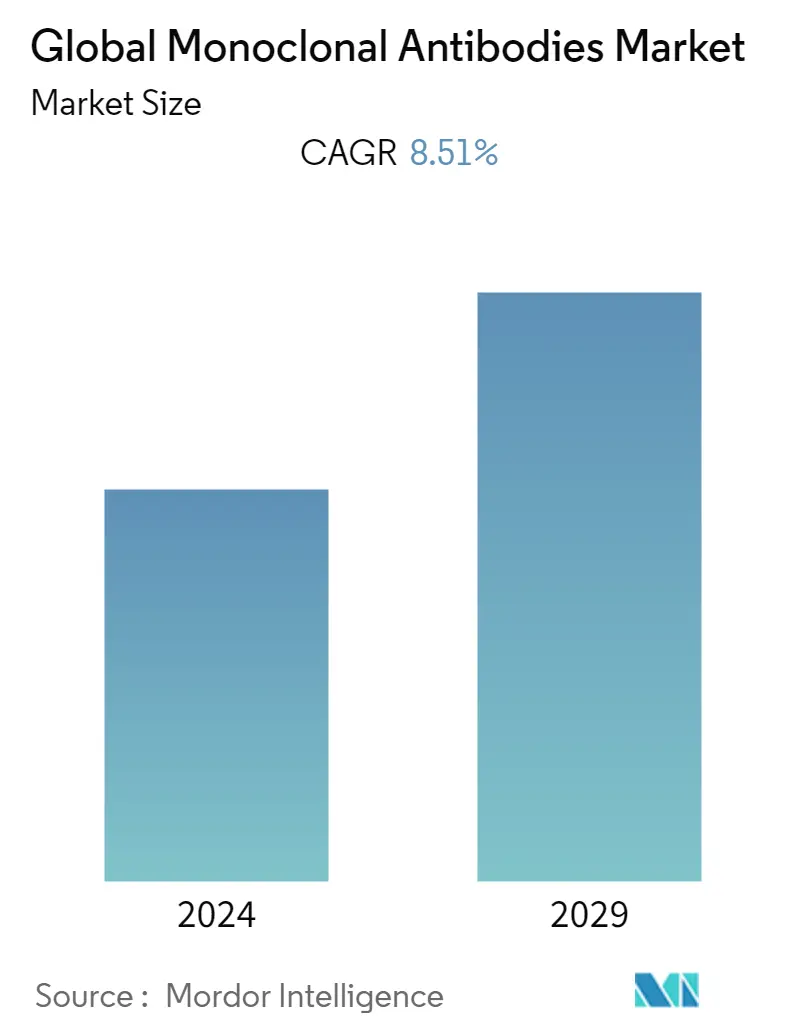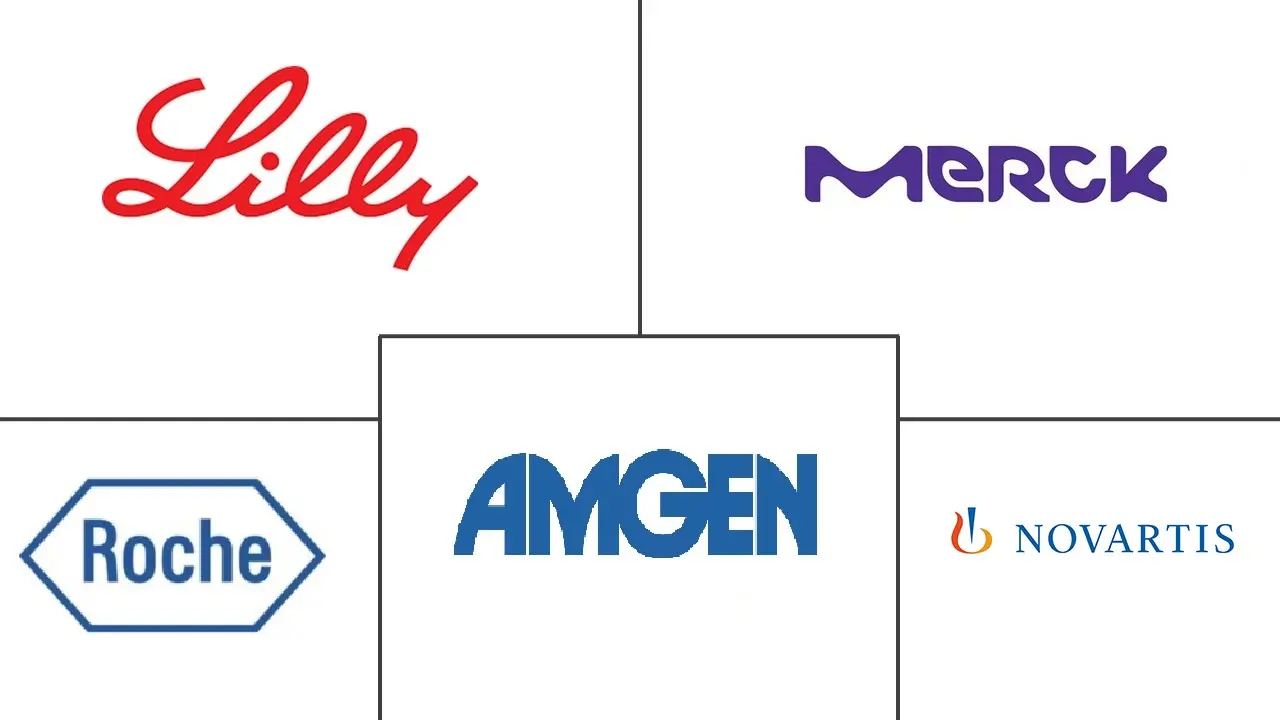Market Size of Global Monoclonal Antibodies Industry

| Study Period | 2019 - 2029 |
| Base Year For Estimation | 2023 |
| CAGR | 8.51 % |
| Fastest Growing Market | Asia Pacific |
| Largest Market | North America |
| Market Concentration | Medium |
Major Players
*Disclaimer: Major Players sorted in no particular order |
Monoclonal Antibodies Market Analysis
The monoclonal antibodies market is expected to register a CAGR of 8.51% during the forecast period (2022-2027).
The monoclonal antibody production was halted due to the COVID-19 pandemic, and it severely affected the global monoclonal antibodies market as they are widely used in cancer and gene therapy, thus affecting the global monoclonal antibodies market. Although COVID-19 was at its peak in Europe and the United States in 2020, few companies were working on new therapy based on monoclonal antibodies to treat COVID-19. They isolated the COVID-19 antibodies from a recovered person and tested them as a cure for COVID-19 infection, and they were successful and got approval for emergency use by the United States Food and Drug Administration. For example, in February 2021, the Food and Drug Administration permitted emergency use of combined bamlanivimab and etesevimab therapy developed by Eli Lilly and Company for people with mild to moderate COVID-19 infection. Moreover, due to the potential application of monoclonal antibodies, it can be expected that COVID-19 will promote the monoclonal antibodies market.
The monoclonal antibodies are becoming ubiquitous in the treatment of different forms of cancer in developed countries, and this has been attributed to the rapid growth of the global monoclonal antibodies market. According to the report of GLOBOCAN 2020, there were 19.3 million new cases of cancer and about 10 million deaths due to cancer in the world, and increasing cancer cases are the major growth factor behind the market. The other factors, which may contribute positively toward the high growth of the global monoclonal antibodies market, are new gene-based therapy, new research related to the application of monoclonal antibodies in treating some other deadly diseases, like COVID-19, disease diagnostics, and treatment of other diseases, like auto-immune, viral disease treatment, and also the approval of new antibodies by governments may lead to the growth of the market. For instance, In January 2022, GlaxoSmithKline plc and Vir Biotechnology, Inc. announced that the United States government will purchase an additional 600,000 doses of sotrovimab, an investigational monoclonal antibody for the early treatment of COVID-19, enabling further nationwide access to sotrovimab for patients.
The cost associating with monoclonal antibodies is very high because of their complex manufacturing procedure and due to the cost involved in R&D, and it is one of the major restraining factors for the growth of the global monoclonal antibodies market. The high cost of monoclonal antibodies is the main reason why it is still prevalent only in developed countries and not in developing and underdeveloped countries. Another factor responsible that can prove a restraint for this market will be the loss of patents by companies.
Monoclonal Antibodies Industry Segmentation
The monoclonal antibodies are cloned from antibodies produced in the body and are used for the treatment of many fatal diseases like cancer, autoimmune diseases, viral disease treatment, and others. The main advantage of using monoclonal antibodies in treating these diseases are they are taken from a biological source and can produce antibodies in the long term. The Monoclonal Antibodies Market is Segmented by Production Methods (In Vivo and In Vitro), Source (Chimeric, Human, Humanized, and Murine), Indication (Cancer, Autoimmune Diseases, Infectious Diseases, Inflammatory Diseases, and Other Indications), End Users (Hospitals, Research Institutes, and Other End Users), and Geography (North America, Europe, Asia Pacific, Middle-East and Africa, and South America). The market report also covers the estimated market sizes and trends for 17 different countries across major regions, globally. The report offers the value (in USD million) for the above segments.
| By Production Methods | |
| In Vivo | |
| In Vitro |
| By Source | |
| Chimeric | |
| Human | |
| Humanized | |
| Murine |
| By Indications | |
| Cancer | |
| Autoimmune Diseases | |
| Infectious Diseases | |
| Inflammatory Diseases | |
| Other Indications |
| By End Users | |
| Hospitals | |
| Research Institutes | |
| Other End Users |
| Geography | ||||||||
| ||||||||
| ||||||||
| ||||||||
| ||||||||
|
Global Monoclonal Antibodies Market Size Summary
The monoclonal antibodies market is poised for significant growth, driven by their increasing application in cancer treatment and gene therapy. The market experienced disruptions due to the COVID-19 pandemic, which halted production activities. However, the pandemic also spurred innovation, as companies developed monoclonal antibody therapies to combat COVID-19, gaining emergency use approvals from regulatory bodies like the United States Food and Drug Administration. This dual role of monoclonal antibodies in treating both cancer and infectious diseases has expanded their market potential. The rising incidence of cancer globally, coupled with advancements in gene-based therapies and research into new applications for monoclonal antibodies, is expected to further propel market growth. Despite the high costs associated with their complex manufacturing processes and research and development, which limit their accessibility in developing regions, the market continues to expand, particularly in developed countries.
North America is anticipated to maintain a dominant position in the global monoclonal antibodies market, supported by a robust healthcare system, substantial government funding for research and development, and a strong presence of key industry players. The region's focus on addressing chronic diseases, such as cancer, through innovative therapies is a significant driver of market expansion. The competitive landscape is characterized by the presence of established companies and new entrants investing in advanced technologies and research. Major players like Eli Lilly, F Hoffmann-La Roche, Merck, Amgen Inc., and Novartis AG are actively engaged in developing and launching new products, as well as forming strategic partnerships to enhance their market share. The ongoing advancements in monoclonal antibody therapies, particularly for cancer and COVID-19, are expected to sustain the market's growth trajectory over the forecast period.
Global Monoclonal Antibodies Market Size - Table of Contents
-
1. MARKET DYNAMICS
-
1.1 Market Overview
-
1.2 Market Drivers
-
1.2.1 Rising Technological Advancements
-
1.2.2 Increasing Burden of Cancer and Other Chronic Diseases
-
1.2.3 Huge Funding by Government for the Research and Development
-
-
1.3 Market Restraints
-
1.3.1 High Cost Pertaining to the Method Involved in the Production of Monoclonal Antibodies
-
1.3.2 Loss of Patents
-
-
1.4 Industry Attractiveness - Porter's Five Forces Analysis
-
1.4.1 Bargaining Power of Buyers/Consumers
-
1.4.2 Bargaining Power of Suppliers
-
1.4.3 Threat of New Entrants
-
1.4.4 Threat of Substitute Products
-
1.4.5 Intensity of Competitive Rivalry
-
-
-
2. MARKET SEGMENTATION
-
2.1 By Production Methods
-
2.1.1 In Vivo
-
2.1.2 In Vitro
-
-
2.2 By Source
-
2.2.1 Chimeric
-
2.2.2 Human
-
2.2.3 Humanized
-
2.2.4 Murine
-
-
2.3 By Indications
-
2.3.1 Cancer
-
2.3.2 Autoimmune Diseases
-
2.3.3 Infectious Diseases
-
2.3.4 Inflammatory Diseases
-
2.3.5 Other Indications
-
-
2.4 By End Users
-
2.4.1 Hospitals
-
2.4.2 Research Institutes
-
2.4.3 Other End Users
-
-
2.5 Geography
-
2.5.1 North America
-
2.5.1.1 United States
-
2.5.1.2 Canada
-
2.5.1.3 Mexico
-
-
2.5.2 Europe
-
2.5.2.1 Germany
-
2.5.2.2 United Kingdom
-
2.5.2.3 France
-
2.5.2.4 Italy
-
2.5.2.5 Spain
-
2.5.2.6 Rest of Europe
-
-
2.5.3 Asia-Pacific
-
2.5.3.1 China
-
2.5.3.2 Japan
-
2.5.3.3 India
-
2.5.3.4 Australia
-
2.5.3.5 South Korea
-
2.5.3.6 Rest of Asia Pacific
-
-
2.5.4 Middle-East and Africa
-
2.5.4.1 GCC
-
2.5.4.2 South Africa
-
2.5.4.3 Rest of Middle-East and Africa
-
-
2.5.5 South America
-
2.5.5.1 Brazil
-
2.5.5.2 Argentina
-
2.5.5.3 Rest of South America
-
-
-
Global Monoclonal Antibodies Market Size FAQs
What is the current Global Monoclonal Antibodies Market size?
The Global Monoclonal Antibodies Market is projected to register a CAGR of 8.51% during the forecast period (2024-2029)
Who are the key players in Global Monoclonal Antibodies Market?
Merck Group, Eli Lilly and Company, Amgen Inc., Novartis AG and F Hoffmann-La Roche AG are the major companies operating in the Global Monoclonal Antibodies Market.

